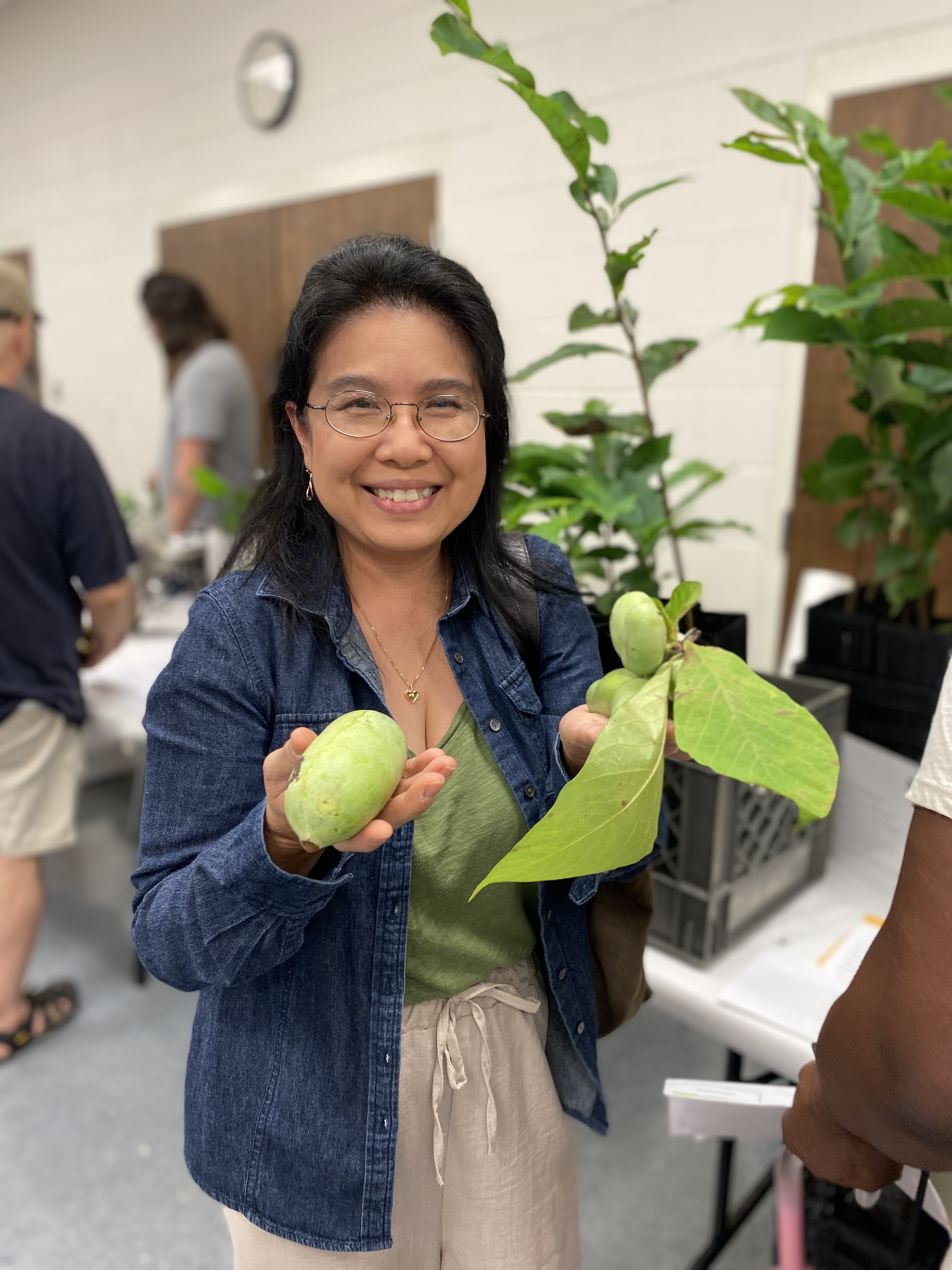Derek Morris – Horticulture Technician shares his love for Pawpaws
go.ncsu.edu/readext?882764
en Español / em Português
El inglés es el idioma de control de esta página. En la medida en que haya algún conflicto entre la traducción al inglés y la traducción, el inglés prevalece.
Al hacer clic en el enlace de traducción se activa un servicio de traducción gratuito para convertir la página al español. Al igual que con cualquier traducción por Internet, la conversión no es sensible al contexto y puede que no traduzca el texto en su significado original. NC State Extension no garantiza la exactitud del texto traducido. Por favor, tenga en cuenta que algunas aplicaciones y/o servicios pueden no funcionar como se espera cuando se traducen.
Português
Inglês é o idioma de controle desta página. Na medida que haja algum conflito entre o texto original em Inglês e a tradução, o Inglês prevalece.
Ao clicar no link de tradução, um serviço gratuito de tradução será ativado para converter a página para o Português. Como em qualquer tradução pela internet, a conversão não é sensivel ao contexto e pode não ocorrer a tradução para o significado orginal. O serviço de Extensão da Carolina do Norte (NC State Extension) não garante a exatidão do texto traduzido. Por favor, observe que algumas funções ou serviços podem não funcionar como esperado após a tradução.
English
English is the controlling language of this page. To the extent there is any conflict between the English text and the translation, English controls.
Clicking on the translation link activates a free translation service to convert the page to Spanish. As with any Internet translation, the conversion is not context-sensitive and may not translate the text to its original meaning. NC State Extension does not guarantee the accuracy of the translated text. Please note that some applications and/or services may not function as expected when translated.
Collapse ▲September 9th, 2023 is the scheduled date for the annual Pawpaw Field Day. Hosted by the N.C. Cooperative Extension, Forsyth County Center, this event promises tropical flavor and community enrichment opportunities. A long standing advocate of the native fruit is Derek Morris. He has been a N.C. Cooperative Extension employee for 23 years, currently serving as a horticulture technician. He was born here in Winston-Salem and he has lived here his entire life. It’s home. The following interview showcases Derek’s passion for pawpaw trees: asimina triloba.
What is your earliest memory in the garden? Probably working for my dad, following him around the vegetable garden when he would plow. I also remember my mother working in her flower beds. I grew up around gardening and I have always loved it.
What is a horticulture technician? I take all of the calls that come into our N.C. Cooperative Extension office. Depending on the nature of the call, I will direct it accordingly: 4-H, growing row crops like soybeans, etc. If the call is horticulture in nature, I will try to answer their questions and if I cannot then I will forward it to either Leslie Rose or Celine Richard, our horticulture agents.
What led you to the NCCE? Toby Bost. He was a neighbor and family friend who noticed my attention and care for my own garden. Collecting plants has been an ongoing passion of mine: roses, irises, day lilies etc. Two years of horticulture in high school gave me a good foundation. Collecting horticulture books has been an ongoing passion and it has increased my gardening and food knowledge.
Why are gardens places of community growth? Everyone loves beauty. Everyone has to eat. It’s important that people know how to grow their own food, especially nowadays. The garden is a place for connection with nature.
NC is a grand state. What makes native plants so vital to the ecosystem?
So many insects and animals depend on native plants. Pawpaw is a good example of the relationship it has with the zebra swallowtail butterfly. It is the only tree in this state that that insect lays its eggs on. That’s a good example of the mutual relationship shared by native plants, insects and animals required for a healthy ecosystem.
In each season of the year there is something new to enjoy. Why do you believe it works that way?
There is a moment in time for everything. Every season has its ups and downs. There is a certain beauty to each season, certain plants that are in their prime. It’s the way it is supposed to be. Fall color, the spring flowers, the summer flowers. This is just the way it is designed.
Is the pawpaw your favorite plant of September?
It is probably my favorite plant every month of the year. Certainly in August and September because I begin to harvest ripe fruit from the middle of August onward and through September. I really look forward to pawpaw season.
What makes the pawpaw tree so special?
Here’s this fruit that is better than most fruit you can get in the grocery store. Very few people know anything about our state’s largest edible fruit. It has a unique, tropical flavor and it’s a beautiful tree. It turns yellow in the fall and has interesting flowers and it’s a beautiful tree in the summer. It is easy to grow and has very few problems. It’s the food source for the zebra swallowtail butterfly. There’s a lot of things to like about the pawpaw.
If someone were taking a walk in the woods, what pointers would you give to help recognize the pawpaw tree?
The trunk is light gray with lenticels, not spiky but spotted. It depends on the time of year. In the fall the large leaves are yellow and their length is easily 8”-10”. The springtime bloom reminds you of a trillium. When the blooms first open they are greenish and then they turn dark in appearance, reddish purple in color. In the wintertime, the flower buds appear like furry brown buttons.
Pollination is one example of the interconnectedness of our ecosystem. How does it work with pawpaw trees?
Bees are not at all interested in pawpaw trees. That sets pawpaw apart from most all of our other fruits. What does pollinate pawpaw trees is flies like carrion flies, flesh flies, blow flies, green bottle flies, also there is a number of beetles like scarab beetles that participate in pollination. Keep in mind that researchers don’t fully know how many different insects pollinate the pawpaw. They have documented lady bugs in the pawpaw blooms. At my home orchard, I’ve seen fruit flies as well in the act of pollination.
How did the first annual pawpaw celebration get started?
Cooperative Extension Area agent Craig Mauney and myself worked together to plan the first pawpaw event that was held in either 2008 or 2009 at the Tanglewood Arboretum. Even though it was raining cats and dogs, over 80 people showed up and we held the event inside of the greenhouse. Since then we have continued to receive strong public support, hosting for several years at the Carolina Classic Fairgrounds and for a few years it was held in a park in Lewisville. For the last few years, the event has been held at our office. Agents Mary Jac Brennan and Celine Richard have both done stellar jobs. Here we have a kitchen, auditoriums, room for parking and the pawpaw orchard which will be open for tours.
There are two great stories about the far reach of pawpaw appeal.
There was a young man from Cleveland, Ohio who flew down with his son to Raleigh and rented a car to drive here for the pawpaw event. That devotion blew my mind. Last year, a guy from upstate New York drove down in his car and spent the night in our parking lot to attend the pawpaw field day. People come out of the woodwork for pawpaws. There is something special about pawpaws that draws people.
How would you describe the presentation and flavor of a pawpaw fruit?
It looks like a green mango. Pawpaws stay green when ripe. Some varieties show a little yellowing. As they age they present dark spots like bananas. Some people prefer to wait until the skin is mostly black. The pawpaws change in flavor like a banana, sweeter the more they ripen. When you cut into it, the fruit is similar to its tropical relatives like cherimoya and guanabana. There are large lima bean sized and shaped seeds inside, anywhere from 3-13, depending on the size of the fruit. The flesh is usually a pretty golden yellow, but there are a few varieties that are considered white or pale yellow. Most varieties are a cheerful golden yellow.
Regarding the flavor, everyone says something different. To me, usually I pick up on cantaloupe, sometimes pineapple and usually there is a background of vanilla, very sweet, very fruity. The flesh consistency is like a thick pudding. The smell can become cloying if you have a bunch of them in a room ripening. The aroma has notes of pineapple, vanilla, sometimes orange and sometimes even coconut. Most people liken the flavor and texture to a mango and banana cross.
Why should people come to the annual pawpaw field day: September 9, 2023? There are going to be lots of good things including vendors selling trees and fruit. People will be able to try pawpaw ice cream and maybe some other value added products made with pawpaw. I have yet to meet a person who didn’t like pawpaw ice cream.
Who should grow pawpaws at home?
Everyone. Butterfly gardeners. As I mentioned before, this is the only tree in our state that is the host plant for the zebra swallowtail to lay their eggs on. For anyone who wants backyard fruit, it’s perfect because it’s pretty much pest free. It doesn’t have to be sprayed. That’s a big plus. Once they’re established they’re a pretty tough tree. You need more than one variety because they do need to be cross pollinated.
If anyone reading this article was unsure about growing in general, who should they call?
They can call me. I’m here at the N.C. Cooperative Extension office, Monday thru Friday 8 a.m.-5 p.m. I’d be glad to answer what I can. Our local horticulture agent for edible plants is Celine Richard. She led the way in planning for this year’s pawpaw field day.
If someone has commercial interests, I would suggest they contact the KSU, Kentucky State University. Dr. Kirk Pomper and Sheri Crabtree have been working with pawpaws since the early 1990’s. They have the world’s largest germplasm there in Kentucky. They have a collection from over twenty states of varieties and clones of the pawpaw tree. They can help people in a commercial direction.
Register for the 2023 Pawpaw Field Day:
Questions:
Derek Morris, horticulture technician, 336-703-2850, dsmorris@ncsu.edu
Celine Richard, horticulture agent, 336-703-2869, cvrichar@ncsu.edu









